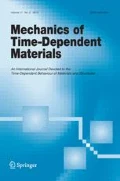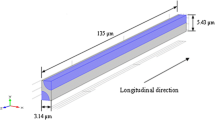Abstract
Mechanical properties of high-temperature polymer matrix composites deteriorate during their service. Oxidation plays a significant role in determining the residual elastic and strength properties of the composite. The present work investigates the oxidative aging damage of cross-ply bismaleimide composites, both experimentally and numerically. Also, this work introduces a better understanding of the significant damage mechanisms, and their respective time ranges. Micro/macro-scale thermo-oxidation behavior and flexural failure were simulated for 1,700 hours of aging. Thermo-oxidation behavior of the cross-ply laminates was simulated using a multi-fiber multi-layer representative volume element. Thermo-oxidation is a diffusion–reaction phenomenon that depends on temperature and oxidation state in time and space domains. In this work, the proportionality between oxidation state evolution and reaction rate was modeled using a new form of time-dependent parameter. Owing to aging damage, the required properties for the flexural test simulation were reduced in the meso-scale. The current study presents a damage state assuming proportionality between the average crack length and oxidized layer thickness based on a continuum damage mechanics approach. Scanning electron micrographs showed that the onset of the “blunt” transverse (through-thickness) micro-cracking/debonding in the superficial layers was at 500 hours under \(176.7~{}^{\circ}\mbox{C}\) (\(350~^{\circ}\mbox{F}\)), where oxidative cracking dominates aging mechanisms. The “blunt” micro-cracks propagated in the transverse direction near 1000 hours rendering the crack faces in contact with the oxidative air. After about 1,700 hours of aging, the weight loss ratio was 0.5%, and the flexural modulus and strength reduced by 19% and 10%, respectively. Prior to 500 hours, where cracking was not noticeable in the “crack-free region”, the strengths reduction was not significant based on the numerical simulations. In the crack-free and oxidative damage dominated regions, the elastic property numerical reduction was significant.















Similar content being viewed by others
References
An, N., Pochiraju, K.: Modeling damage growth in oxidized high-temperature polymeric composites. JOM 65, 246–255 (2013)
Antoun, B., Qi, H.J., Hall, R., Tandon, G.P., Lu, H., Lu, C., Furmanski, J., Amirkhizi, A.: Challenges in Mechanics of Time-Dependent Materials and Processes in Conventional and Multifunctional Materials. Springer, Berlin (2014)
ASTM Standard D317-11: Standard test methods for constituent content of composite materials. ASTM International, West Conshohocken, PA (2011)
Boyd, J., Bongiovanni, C.L., Thai, B.: Bismaleimide resin with high temperature thermal stability. U.S. Patent 2007/0117956 A1, May 24, 2007
Chung, K., Seferis, J.C., Nam, J.D.: Investigation of thermal degradation behavior of polymeric composites: prediction of thermal cycling effect from isothermal data. Composites, Part A, Appl. Sci. Manuf. 31, 945–957 (2000)
Colin, X., Marais, C., Verdu, J.: Thermal oxidation kinetics for a poly (bismaleimide). J. Appl. Polym. Sci. 82, 3418–3430 (2001)
Haque, M.H., Upadhyaya, P., Roy, S., Ware, T., Voit, W., Lu, H.: The changes in flexural properties and microstructures of carbon fiber bismaleimide composite after exposure to a high temperature. Compos. Struct. 108, 57–64 (2014)
Hussein, R.M., Anadan, S., Chandrashekhara, K.: Anisotropic oxidation prediction using optimized weight loss behavior of bismaleimide composites. J. Mater. Sci. 51, 7236–7253 (2016)
Lafarie-Frenot, M.C.: Damage mechanisms induced by cyclic ply-stresses in carbon-epoxy laminates: environmental effects. Int. J. Fatigue 28, 1202–1216 (2006)
Liang, J., Pochiraju, K.: Oxidation-induced damage evolution in a unidirectional polymer matrix composite. J. Compos. Mater. 49, 1393–1406 (2015)
Luo, H., Roy, S., Lu, H.: Dynamic compressive behavior of unidirectional Im7/5250-4 laminate after thermal oxidation. Compos. Sci. Technol. 72, 159–166 (2012)
Luo, H., Lu, G., Roy, S., Lu, H.: Characterization of the viscoelastic behavior of bismaleimide resin before and after exposure to high temperatures. Mech. Time-Depend. Mater. 17, 369–399 (2013)
McManus, H.L., Chamis, C.C.: Stress and damage in polymer matrix composite materials due to material degradation at high temperatures. NASA Technical Memorandum, 4682 (1996)
Meng, M., Le, H.R., Rizvi, M.J., Grove, S.M.: 3D FEA modelling of laminated composites in bending and their failure mechanisms. Compos. Struct. 119, 693–708 (2015)
Painter, P.C., Coleman, M.M.: Fundamentals of Polymer Science: An Introductory Text, 2nd edn. CRC Press, Boca Raton (1997)
Pochiraju, K.V., Tandon, G.P., Schoeppner, G.A.: Evolution of stress and deformations in high-temperature polymer matrix composites during thermo-oxidative aging. Mech. Time-Depend. Mater. 12, 45–68 (2008)
Roy, S., Sing, S.: Prediction of thermo-oxidative degradation in polymer matrix composites using micromechanical modeling and homogenization at the macro-scale. Mech. Adv. Mat. Struct. 19, 68–78 (2012)
Roy, S., Sing, S., Schoeppner, G.A.: Modeling of evolving damage in high temperature polymer matrix composites subjected to thermal oxidation. J. Mater. Sci. 43, 6651–6660 (2008)
Scheirs, J.: Compositional and Failure Analysis of Polymers a Practical Approach. Wiley, New York (2000)
Schoeppner, G.A., Tandon, G.P., Ripberger, E.R.: Anisotropic oxidation and weight loss in PMR-15 composites. Composites, Part A, Appl. Sci. Manuf. 38, 890–904 (2007)
Schoeppner, G.A., Tandon, G.P., Pochiraju, K.V.: Multiscale Modeling and Simulation of Composite Materials and Structures. Springer, Berlin (2008)
Talreja, R.: Multi-scale modeling in damage mechanics of composite materials. J. Mater. Sci. 41, 6800–6812 (2006)
Tuttle, M.E.: Structural Analysis of Polymeric Composite Materials. CRC Press, Boca Raton (2003)
Upadhyaya, P., Sing, S., Roy, S.: A mechanism-based multi-scale model for predicting thermo-oxidative degradation in high temperature polymer matrix composites. Compos. Sci. Technol. 71, 1309–1315 (2011)
Upadhyaya, P., Roy, S., Haque, M.H., Lu, H.: Influence of nano-clay compounding on thermo-oxidative stability and mechanical properties of a thermoset polymer system. Compos. Sci. Technol. 84, 8–14 (2013)
Vu, D.Q., Gigliotti, M., Lafarie-Frenot, M.C.: The effect of thermo-oxidation on matrix cracking of cross-ply [0/90]S composite laminates. Composites, Part A, Appl. Sci. Manuf. 44, 114–121 (2013)
Wang, C., Gunnion, A., Orifici, A., Rider, A.: Residual strength of composite laminates containing scarfed and straight-sided holes. Composites, Part A, Appl. Sci. Manuf. 42, 1951–1961 (2011)
Witik, R.A., Gaille, F., Teuscher, R., Ringwald, H., Michaud, V., Manson, J.: Assessing the economic and environmental potential of out-of-autoclave processing. In: Proceedings of 18th ICCM, pp. 1–6 (2011)
Author information
Authors and Affiliations
Corresponding author
Ethics declarations
Conflict of interest
The authors declare that they have no conflict of interest.
Rights and permissions
About this article
Cite this article
Hussein, R.M., Anandan, S., Dhaliwal, G.S. et al. Multi-scale modeling of thermo-oxidation effects on the flexural behavior of cross-ply bismaleimide composites. Mech Time-Depend Mater 23, 53–73 (2019). https://doi.org/10.1007/s11043-018-9392-1
Received:
Accepted:
Published:
Issue Date:
DOI: https://doi.org/10.1007/s11043-018-9392-1




